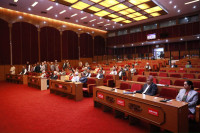Columns
Building resilience against disasters
As a disaster-prone country, it is essential for Nepal to prepare for future disasters..jpg&w=900&height=601)
Kikuta Yutaka
On April 25, 2015, just before noon, I felt a tremor at my residence in New Delhi. At that time, I was the Deputy Chief of Mission of the Embassy of Japan in India. I called my colleagues in the Embassy to confirm the epicentre of the earthquake, and I came to know that it was not in India, but in Nepal. Rather than relieved, I was stunned by the magnitude of the earthquake. Even today, I still vividly remember that I hurried to the Ministry of External Affairs of India to coordinate a special flight to Kathmandu for the Japan Disaster Relief Team.
I can well imagine the suffering and pain of Nepal and the Nepali people in the wake of the Gorkha earthquake. At the same time, I would like to express my sincere respect to Nepali people for their reconstruction efforts.
I would like to take this opportunity to reiterate our condolences to the victims and their families and also to look back at the various assistances Japan has extended over the past eight years since the earthquake. I also would like to express my heartfelt gratitude to the Government of Nepal and the people involved for their cooperation in implementing these projects.
Japan started to support Nepal immediately after the earthquake. The Japan Disaster Relief Team was dispatched to provide rescue and medical services. In addition to the Emergency Relief Goods, Japan provided Emergency Grant Aid to international and other organisations and arranged various activities with them to help Nepal in the catastrophe.
In addition to these immediate relief assistances, in order to help Nepal’s reconstruction, Japan announced approximately $260 million of assistance at the International Conference on Nepal’s Reconstruction, which was held in Kathmandu on June 25, 2015, two months after the earthquake.
Following the announcement, Exchange of Notes on loan assistance for the Emergency School Reconstruction Project (ESRP) and the Emergency Housing Reconstruction Project were signed in December 2015. The grant assistance to restore bridges and roads, hospitals, and other infrastructure damaged by the earthquake was also introduced. The ESRP just completed its mission this month, April 2023, with the reconstruction of as many as 274 schools. Japan is a country which keeps her word.
These projects were implemented based on the concept of “Build Back Better”, which aims to improve the earthquake resilience of Nepal, rather than simply bringing back facilities to their original state.
Furthermore, Japan provided assistance under a variety of schemes. One example is the programme for the restoration of Nepal’s pride cultural heritages. Another is the grants to the Grassroots Human Security Projects, which were non-refundable financial assistance to non-profit organisations, including Nepali NGOs, to help the revival of education hubs in communities in areas with difficult access. These are unique Japanese schemes to meet the needs of local communities by directly supporting the activities undertaken by NGOs and local authorities.
We also supported the institutional development and capacity building of Nepal in the area of disaster management mechanisms, such as the formulation of resilient plans for rehabilitation and recovery from disasters. It is essential for Nepal to prepare for future disasters, as it is one of the most disaster-prone countries in the world, with a high risk of natural hazards. Technical cooperation projects, which require the local communities to participate in the reconstruction process, were also provided.
Apart from the support to the post-earthquake rehabilitation and reconstruction, the Government of Japan has contributed to the large-scale infrastructure projects in Nepal for decades, as it is widely known among the Nepali people. I would like to point out that these newly built infrastructure projects have disaster management aspects too.
For instance, the ongoing Nagdhunga Tunnel Construction Project, the first mountain road tunnel project in Nepal, is expected not only to ease traffic congestion due to the rapidly increasing traffic volume and shorten travel time, but also to improve the safety in this mountainous area and reduce the risks of landslide accidents and other natural disaster.
In the coming days, it will be important for a developed Nepal to implement public works projects on its own, based on the experience of the reconstruction process so far, and bearing in mind the idea to build more resilient and durable infrastructures and facilities, even if it may cost more or take longer to complete.
I also would like to share Japanese experiences on how to raise awareness of disaster prevention through education and the social community. Japan has been making strenuous efforts to prevent and mitigate disaster damage, establish an immediate alert system, share disaster information within local communities, and promote disaster-prevention education. Japan has established September 1 as “Disaster Prevention Day”, in commemoration of the Great Kanto Earthquake on September 1, 1923. Every year, on that day, evacuation drills are conducted throughout the country to help people recall the importance of disaster prevention.
Today marks eight years since the occurrence of the Gorkha earthquake. From my point of view, everyone, not only the Government of Nepal, but the local governments, communities and all the people in Nepal, should keep learning the important lessons from the experiences of the earthquake, and participate in the process to establish a disaster resilient society. Japan, which is, like Nepal, a disaster-prone country and has frequently suffered from natural disasters, also has learned many lessons through its experiences of numerous earthquakes and other natural disasters. I hope that today will be a day for everyone to recollect the lessons from the Gorkha earthquake and its aftermath for a better future, just like Japanese people have been doing since the Great Kanto Earthquake, which took place one century ago.
It is my sincere hope that the numerous post-earthquake reconstruction assistance projects implemented by Japan in collaboration with the Government of Nepal will not only lead to the rehabilitation, reconstruction and improvement in the resilience of Nepal, but will also further strengthen the friendly relations that Japan and Nepal have developed over the years.
The year 2026, when Nepal aims to graduate from the LDC category, will also mark the 70th anniversary of the establishment of diplomatic relations between Japan and Nepal. I expect that bilateral relations will be further enhanced in the run-up to that momentous year.




 8.12°C Kathmandu
8.12°C Kathmandu















